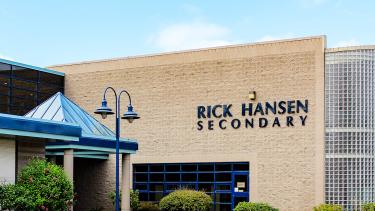
School Name History
Location
31150 Blueridge Drive, Abbotsford, BC
Opened
1993
The School
The school was completed in 1993 and enrolled one thousand students from Grades 8-11. The final cost was twenty-one million dollars. The school was designed to be fully accessible with wider hallways and classrooms, washrooms, and bleachers were built to accommodate wheelchairs. Elevators provided access to all rooms in the school. The walls are all rounded to facilitate travel in the school’s corridors.
The school also provides help for people with visual or hearing disabilities. Dark-coloured railings against light walls make it easy for visually impaired students to see and use. The classrooms have reflective panels to absorb background noise yet carry sound to help those with hearing challenges listen to a lecture.
In 2016, Rick Hansen Secondary became the province’s first school of science and business. Students are encouraged to enter professional careers in business, science, and medicine, better prepared for success in university.
Origin of the Name
Rick Hansen Secondary was named after the wheelchair athlete who worked tirelessly to raise the public’s awareness of people with physical disabilities. Rick Hansen raised significant funds to help spinal cord injury research and promote accessibility in buildings for everyone. Hansen had a special connection to Abbotsford. When he attended the school opening, he said, “It’s a special feeling to know that the values that I live every day are part of this school and my hometown. I lived here for six years, but I still consider it my hometown.”
Hansen said that when the Abbotsford school board first asked his permission to use his name, he was reluctant. However, he was convinced to agree by the board’s commitment to making the school accessible to everyone. Hansen served as a consultant for the project and this project became a flagship for the construction of other fully accessible buildings. Rick Hansen Secondary was the first school in Canada designed to be used by both able-bodied and physically challenged people.
The Abbotsford School District graciously acknowledges the Abbotsford Retired Teachers Association for collecting the histories and stories of our schools as part of their "What's in a name?" 50th-anniversary project.
Rick Hansen (1957-)
Richard (Rick) Marvin Hansen was born on August 26, 1957, in Port Alberni, BC. He grew up in various B.C. communities including Fort St. John, Abbotsford, and Williams Lake. When he was fifteen years old, he was thrown from the back of a pickup truck. He suffered a spinal cord injury, becoming a paraplegic who was paralyzed from the waist down.
After hospitalization and rehabilitation, and with the support of his mentor, Stan Stronge, Rick began to play wheelchair basketball. He enrolled at the University of British Columbia in 1976. He was the first person with a physical disability to graduate with a degree in physical education.
Over the next few years, Rick won nineteen wheelchair marathons, four world titles, and became Canada’s Disabled Athlete of the Year in 1979, 1980, and 1982. During this time, he played wheelchair basketball with Terry Fox, Eugene Reimer and Stan Stronge. All these men were athletes and leaders in organizations for wheelchair sports.
After much work in planning and organizing, Rick set out on his famous Man in Motion World Tour in 1985. His goal was to raise awareness of the potential of people with physical disabilities. He was away for two years, journeying through thirty-four countries, promoting accessibility and inclusiveness, and raising twenty-six million dollars towards this goal.
The Rick Hansen Foundation was founded to continue promoting his goals. The Rick Hansen Institute deals with spinal cord injuries and the Rick Hansen School program provides resources to empower young people and raise awareness. As of 2023, he remained president and Chief Executive Officer of the Rick Hansen Foundation, which has raised hundreds of millions of dollars for programs helping those with spinal cord injuries.
Rick married his physiotherapist, Amanda Reid, in October of 1987. They moved to Brisbane, Australia, where Rick was appointed Commissioner-General of the Canadian Pavilion for Expo ‘88. They moved back to Canada in 1988, and over the next few years added three daughters to their family: Emma, Alanna, and Rebecca.
Rick has received many honours over the years. He was inducted into the Companion of the Order of Canada in 1987 and the Order of BC in 1992. Rick also received the Queen Elizabeth II Golden Jubilee Commemorative Medal from the Governor General of Canada. He has been inducted into the Canadian Sports Hall of Fame as well as the BC Sports Hall of Fame. He was one of the final four torchbearers for the Vancouver 2010 Olympic Winter Games, carrying the flame into BC Place. In 2017, Rick became an Ambassador for the Invictus Games in Toronto, Canada.
Rick continues to advocate for change, inspiring and engaging audiences through his public appearances, as well as working closely with organizations and governments to raise awareness of physical disabilities.